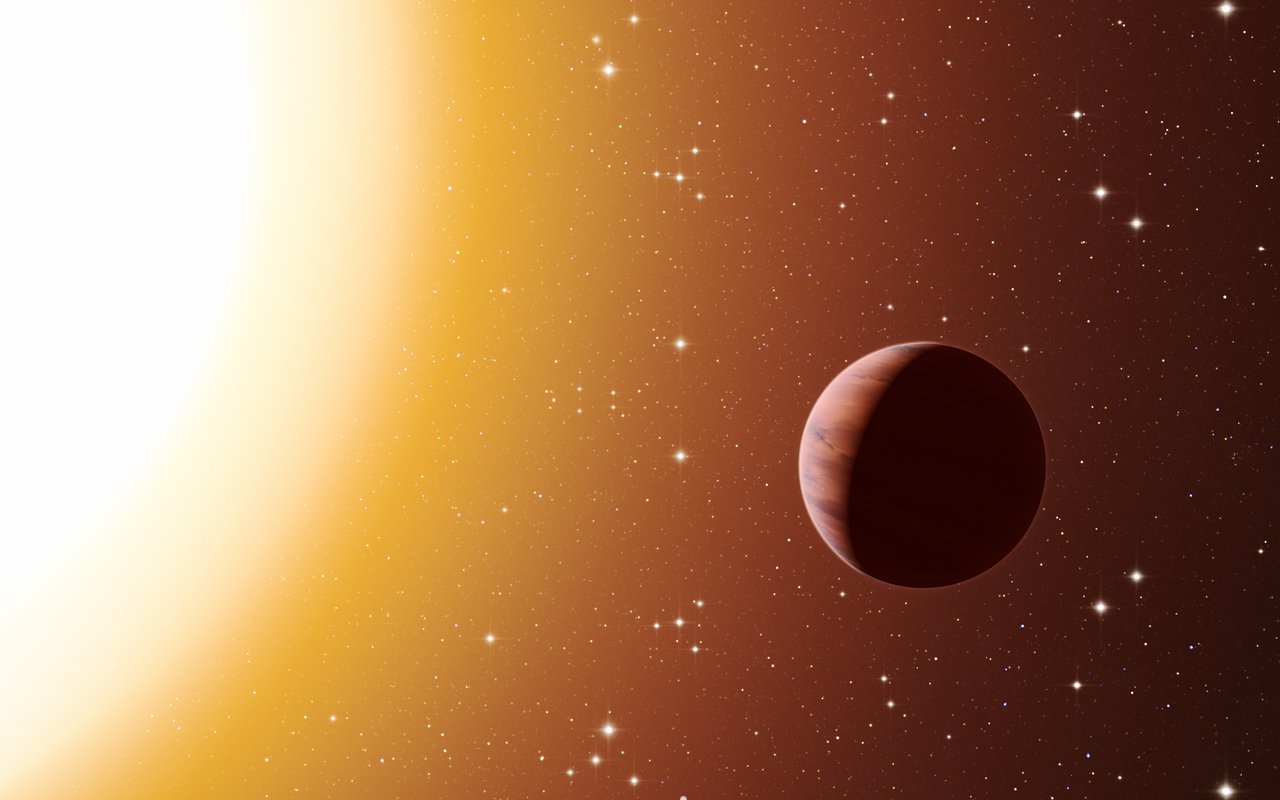SRON-astronomen hebben de aanwezigheid van aluminiumoxide (AlO) gevonden in het spectrum van exoplaneet WASP-43b. Dit komt als een verrassing omdat verwacht wordt dat AlO verscholen zit in de lagere atmosferische lagen. Het is pas de tweede keer dat astronomen het molecuul in de atmosfeer van een exoplaneet waarnemen.

Misschien lijken planeten als Mars en Jupiter ver weg, maar die afstanden zijn nog niets vergeleken bij exoplaneten. Als je ‘s nachts omhoog kijkt naar de sterrenhemel en op zoek gaat naar de dichtstbijzijnde exoplaneet—een planeet zo groot als de Aarde die rond Proxima Centauri draait—kun je net zo goed zoeken naar de voetafdrukken op de Maan. En dat is alleen nog maar qua omvang; exoplaneten schijnen ongeveer een miljard keer zwakker dan hun moederster. Daarom gebruiken astronomen veelal indirecte detectiemethodes om planeten te identificeren rond andere sterren. Ze zoeken naar dipjes in de intensiteit van een ster, veroorzaakt door de planeet als hij voorlangs vliegt, of ze kijken of een ster een beetje op en neer wiebelt, door de aantrekkingskracht van de planeet. Om de samenstelling te onderzoeken van de atmosfeer rond een exoplaneet, meten sterrenkundigen zijn spectrum—de streepjescode die in het sterlicht wordt afgedrukt als het licht door de atmosfeer trekt.
Astronomen van SRON Netherlands Institute for Space Research hebben nu onverwachts de aanwezigheid aangetoond van aluminiumoxide (AlO) in de atmosfeer van een exoplaneet. Ze bestudeerden de exoplaneet WASP-43b, een planeet ter grootte van Jupiter die in een nauwe baan om zijn moederster WASP-43 draait, op 284 lichtjaar van de Aarde. Normaal gesproken zou je verwachten dat AlO diep verscholen zit onder de atmosfeer, onzichtbaar voor het infrarood-instrument van de Hubble ruimtetelescoop die de onderzoekers gebruikten. Een logische verklaring is dat een sterke wind de atmosferische lagen opschudt.
‘De aanwezigheid van AlO in een regio die we kunnen analyseren is erg spannend, want het komt echt onverwacht,’ zegt eerste auteur Katy Chubb. ‘Het is pas de tweede keer dat iemand het vindt in de atmosfeer van een exoplaneet. Het is nu nog een raadsel waarom we het zien, want we verwachten dit niet bij de temperatuur en druk die gelden in de regio die we onderzoeken. Als we gaan speculeren, zou een sterke turbulentie de oorzaak kunnen zijn, die dan gas naar boven haalt vanuit onderin de atmosfeer.’
Toekomstige telescopen zoals de James Webb ruimtetelescoop en ARIEL—met bijdragen van SRON—zullen sterrenkundigen meer inzicht geven in hete reuzenexoplaneten zoals WASP-43b. Dan kunnen ze onder meer uitvogelen of de aanwezigheid van AlO wijdverspreid is, en daarmee ook meer te weten komen over de dynamiek en vorming van deze planeten.
Publicatie
Katy L. Chubb, Michiel Min, Yui Kawashima, Christiane Helling, and Ingo Waldmann, ‘Aluminium oxide in the atmosphere of hot Jupiter WASP-43b’, Astronomy & Astrophysics
Astronomers see unexpected molecule in exoplanet atmosphere
SRON-astronomers have found the signature for aluminium oxide (AlO) in the spectrum of exoplanet WASP-43b. This came as a surprise because AlO is expected to stay hidden in the lower atmospheric layers. It is only the second time that astronomers observe the molecule in an exoplanet’s atmosphere.

If you think planets like Mars or Jupiter are far away, try exoplanets. When you look up at the night sky and search for the closest exoplanet—an Earth-sized planet orbiting Proxima Centauri—you might as well look for the footprints on the Moon. And that is only considering size; exoplanets are outshined by their host star about a billion times. That’s why astronomers mostly use indirect observation methods to identify planets around other stars. They look for dips in the intensity of a star, caused by a planet moving in front of it, or determine whether a star wobbles a bit, because of a planet’s gravity. To examine the composition of an exoplanet’s atmosphere, astronomers measure its spectrum—the bar code imprinted in the starlight as the light passes through the atmosphere.
Astronomers from SRON Netherlands Institute for Space Research have now inferred the unexpected presence of alumunium oxide (AlO) in an exoplanet’s atmosphere. They examined exoplanet WASP-43b, a Jupiter-sized planet in close orbit around its host star WASP-43 at 284 lightyears from Earth. AlO would normally hide deep in the atmosphere, invisible to the infrared instrument of the Hubble Space Telescope used by the researchers. One logical explanation is that strong winds shake up the atmospheric layers.
‘The presence of AlO in the region of the atmosphere we can analyze is very exciting, as it’s really unexpected,’ says first author Katy Chubb. ‘It’s only the second time that anyone has seen some evidence of it in an exoplanet atmosphere. It is currently a mystery as to why we are seeing it, as it’s not expected at the temperatures and pressures of the region we are probing. We can speculate as to the reasons, which includes the presence of strong turbulence dredging up gas from lower down in the atmosphere.’
Future telescopes such as the James Webb Space Telescope and ARIEL—with contributions from SRON—will give astronomers more insight into warm giant exoplanets such as WASP-43b. It will help them to figure out if the presence of AlO is widespread, and therefore learn more about the dynamics and formation of these planets.
Publication
Katy L. Chubb, Michiel Min, Yui Kawashima, Christiane Helling, and Ingo Waldmann, ‘Aluminium oxide in the atmosphere of hot Jupiter WASP-43b’, Astronomy & Astrophysics


